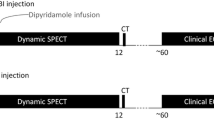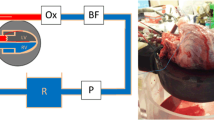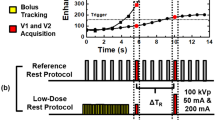Abstract
Diffusely impaired coronary blood flow reserve is difficult to measure non-invasively. We developed and tested a quantitative non-invasive method of measuring coronary blood flow reserve using thallium-201 perfusion imaging. Ten anesthetized dogs were injected simultaneously at rest with thallium-201 and either Ru-103 or Sn-113 microspheres. SPECT images were obtained followed by varying doses of intravenous adenosine, and a second thallium-201 dose was injected simultaneously with either Nb-95 or Sc-46 microspheres. SPECT images were then repeated. The heart was removed, sectioned and counted, along with arterial blood samples. Blood flow was calculated at rest and stress. Peak resting counts in four regions in each of three SPECT slices were subtracted from stress values and stress/rest thallium-201 count ratios (coronary flow reserve (CFR)) were calculated and correlated with the corresponding microsphere flow ratios. Overall correlation of the imaging and microsphere flow ratios was 0.77 (p = 0.0001). Regional correlation coefficients ranged from 0.65–0.86 (p = 0.0001). Coronary blood flow reserve ratios by the microsphere method ranged from 0.7 to 5.3, and by thallium-201 imaging from 0.33–2.45. The non-invasively measured coronary blood flow reserve with thallium-201 imaging and adenosine stress correlates well with microsphere-measured coronary blood flow reserve over a wide range of coronary flows, and should be useful in clinical studies of CFR impairment.
Similar content being viewed by others
References
Marcus ML, Harrison DG, Chilian WM, et al. Alterations in the coronary circulation in hypertrophied ventricles. Circulation 1987; 75(Suppl. I): 1-19.
Polese A, DeCesare N, Montorsi P, et al. Upward shift of the lower range of coronary flow autoregulation in hypertensive patients with hypertrophy of the left ventricle. Circulation 1991; 83: 845-853.
Nahser PJ, Brown RE, Oskarsson H, Winniford MD, Rossen JD. Maximal coronary flow reserve and metabolic coronary vasodilation in patients with diabetes mellitus. Circulation 1995; 91: 635-640.
Gould KL, Lipscomb K, Hamilton GW. Physiologic basis for assessing critical coronary stenosis. Am J Cardiol 1974; 33: 87-92.
White CW, Wright CB, Doty DB, et al. Does visual interpretation of the coronary arteriogram predict the physiologic importance of a coronary stenosis? N Engl J Med 1984; 310: 819-824.
Strauer BE. The concept of coronary flow reserve. J Cardiovasc Pharmacol 1992; 19(suppl. 5): S67-S79.
Rossen JD, Oskarsson H, Stenberg RG, et al. Simultaneous measurement of coronary flow reserve by left anterior descending coronary artery Doppler and great cardiac vein thermodilution methods. J Am Coll Cardiol 1992; 20: 402-407.
Goldstein RA, Mullani NA, Marani SK, et al. Myocardial perfusion with Rubidium-82. II. Effects of metabolic and pharmacologic interventions. J Nucl Med 1983; 24: 907-912.
Sobel BE. Positron tomography and myocardial metabolism: an overview. Circulation 1985; 72(Suppl. IV): 22-30.
Mullani N, Gould KL. First-pass measurements of regional blood flow with external detectors. J Nucl Med 1983; 24: 577-582.
Gould KL, Schelbert HR, Phelps ME, Hoffman EJ. Noninvasive assessment of coronary stenoses with myocardial perfusion imaging during pharmacologic coronary vasodilation. Am J Cardiol 1979; 43: 200-204.
Mullani NA, Goldstein RA, Gould KL, et al. Myocardial perfusion with rubidium-82 I. Measurement of extraction fraction and flow with external detectors. J Nucl Med 1983; 24: 898-905.
Schelbert HR, Phelps ME, Huang SC, et al. N-13 labeled ammonia as an indicator of myocardial blood flow. Circulation 1981; 63: 1259-1263.
Bellina CR, Parodi O, Camici P, et al. Simultaneous in vitro and in vivo validation of Nitrogen-13-ammonia for the assessment of regional myocardial blood flow. J Nucl Med 1990; 31: 1335-1340.
Hutchins GD, Schwaiger M, Rosenspirc KC, et al. Noninvasive quantification of regional blood flow in the human heart using N-13 ammonia and dynamic positron emission tomographic imaging. J Am Coll Cardiol 1990; 15: 1032-1042.
Parker JA, Beller GA, Hoop B, Holman BL, Smith TW. Assessment of regional myocardial blood flow and regional fractional oxygen-extraction in dogs, using O-15 water and O-15 hemoglobin. Circ Res 1978; 42: 511-516.
Merlet P, Mazoyer B, Hittinger L, et al. Assessment of coronary reserve in man: comparison between positron emission tomography with oxygen-15-labeled water and intracoronary doppler technique. J Nuc Med 1993; 34: 1899-1904.
Legrand V, Mancini GB, Bates ER, et al. Comparative study of coronary flow reserve, coronary anatomy and results of radionuclide exercise tests in patients with coronary artery disease. J Am Coll Cardiol 1986; 8: 1022-1032.
Houghton JL, Frank MJ, Carr AA, et al. Relations among impaired coronary flow reserve, left ventricular hypertrophy and thallium perfusion defects in hypertensive patients without obstructive coronary artery disease. J Am Coll Cardiol 1990; 15: 43-51.
Bateman TM, Maddahi J, Gray RJ, et al. Diffuse slow washout of myocardial thallium-201: a new scintigraphic indicator of extensive coronary artery disease. J Am Coll Cardiol 1984; 4: 55-64.
Heymann MA, Payne BD, Hoffman JIE, Rudolph AM. Blood flow measurements with radionuclide-labeled particles. Prog Cardiovasc Dis 1977; 20: 55-79.
Solzbach U, Liao J, Whiting JS, Eigler NL. Digital angiographic impulse response analysis of myocardial perfusion: influence of heart rate and blood pressure changes on microcirculatory transit time measurement in the normal canine coronary circulation. Comput Biomed Res. 1995; 28: 371-392.
Diamond JA, Gharavi AG, Roychoudhury D, et al. Effect of long-term eprosartan versus enalapril antihypertensive therapy on left ventricular mass and coronary flow reserve in stage I–II hypertension. Curr Med Res Opin. 1999; 15: 1-8.
Diamond JA, Krakoff LR, Goldman A, et al. Comparison of two extended release calcium channel blockers on hemodynamics, left ventricular mass and coronary vasodilatory reserve in moderate to severe hypertension. Am J Hypertens 2001; 14: 231-240.
Nielsen AP, Morris KG, Murdock R, Bruno FP, Cobb FR. Linear relationship between the distribution of thallium-201 and blood flow in ischemic and non-ischemic myocardium during exercise. Circulation 1980; 61: 797-801.
Beller GA, Watson DD, Ackell P, Pohost GM. Time course of thallium-201 redistribution after transient myocardial ischemia. Circulation 1980; 61: 79-87.
Wilson RF, Wyche K, Christensen BV, Zimmer S, Laxson DD. Effects of adenosine on human coronary arterial circulation. Circulation 1990; 82: 1595-1606.
Christensen CW, Rosen LB, Gal RA, et al. Coronary vasodilator reserve. Comparison of the effects of papaverine and adenosine on coronary flow, ventricular function and myocardial metabolism. Circulation 1991; 83: 294-303.
Opherk D, Mall G, Zebe H, et al. Reduction of coronary reserve: a mechanism for angina pectoris in patients with arterial hypertension and normal coronary arteries. Circulation 1984; 69: 1-8.
Sax FL, Cannon RO, Hanson C, Epstein SE. Impaired forearm vasodilator reserve in patients with microvascular angina. N Engl J Med 1987; 317: 1366-1374.
Geltman EM, Henes CG, Senneff MJ, et al. Increased myocardial perfusion at rest and diminished perfusion in patients with angina and angiographically normal coronary arteries. J Am Coll Cardiol 1990; 16: 586-591.
Cannon RO, Cunnion RE, Parillo JE, et al. Dynamic limitation of coronary vasodilator reserve in patients with dilated cardiomyopathy and chest pain. J Am Coll Cardiol 1987; 10: 1190-1197.
O'Connell JB, Bourge RC, Costanzo-Nordin MR, et al. Cardiac transplantation: recipient selection, donor procurement, and medical follow up. Circulation 1992; 86: 1061-1066.
Author information
Authors and Affiliations
Rights and permissions
About this article
Cite this article
Diamond, J.A., Machac, J., Vallabhajosula, S. et al. Validation in the canine model of a new non-invasive method of measuring coronary blood flow reserve: Split dose thallium-201 rest/stress imaging. Int J Cardiovasc Imaging 17, 145–152 (2001). https://doi.org/10.1023/A:1010627423924
Issue Date:
DOI: https://doi.org/10.1023/A:1010627423924




